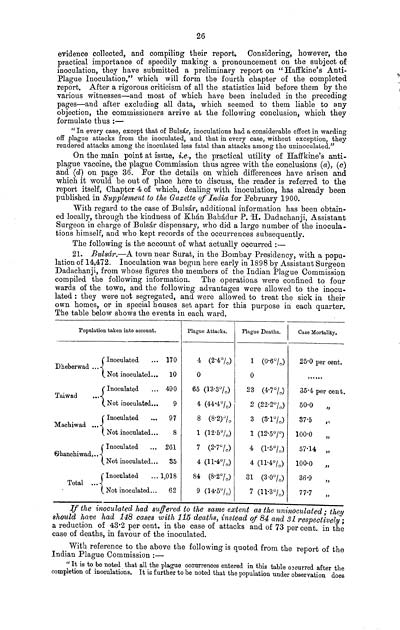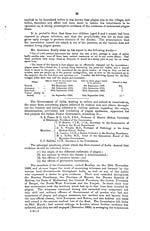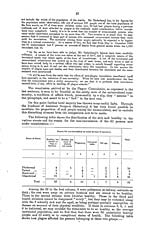Medicine - Disease > Statistics of inoculations with Haffkine's anti-plague vaccine 1897-1900
(30) Page 26
Download files
Individual page:
Thumbnail gallery: Grid view | List view

26
evidence collected, and compiling their report. Considering, however, the
practical importance of speedily making a pronouncement on the subject of
inoculation, they have submitted a preliminary report on " Haffkine's Anti-
Plague Inoculation," which will form the fourth chapter of the completed
report. After a rigorous criticism of all the statistics laid before them by the
various witnesses-and most of which have been included in the preceding
pages-and after excluding all data, which seemed to them liable to any
objection, the commissioners arrive at the following conclusion, which they
formulate thus :-
"In every case, except that of Bulsr, inoculations had a considerable effect in warding
off plague attacks from the inoculated, and that in every case, without exception, they
rendered attacks among the inoculated less fatal than attacks among the uninoculated."
On the main point at issue, i.e., the practical utility of Haffkine's anti-
plague vaccine, the plague Commission thus agree with the conclusions (a), (c)
and (d) on page 36. For the details on which differences have arisen and
which it would be out of place here to discuss, the reader is referred to the
report itself, Chapter 4 of which, dealing with inoculation, has already been
published in Supplement to the Gazette of India for February 1900.
With regard to the case of Bulsr, additional information has been obtain-
ed locally, through the kindness of Khn Bahdur P. H. Dadachanji, Assistant
Surgeon in charge of Bulsr dispensary, who did a large number of the inocula-
tions himself, and who kept records of the occurrences subsequently.
The following is the account of what actually occurred :-
21. Bulsr.-A town near Surat, in the Bombay Presidency, with a popu-
lation of 14,472. Inoculation was begun here early in 1898 by Assistant Surgeon
Dadachanji, from whose figures the members of the Indian Plague Commission
compiled the following information. The operations were confined to four
wards of the town, and the following advantages were allowed to the inocu-
lated : they were not segregated, and were allowed to treat the sick in their
own homes, or in special houses set apart for this purpose in each quarter.
The table below shows the events in each ward.
Population taken into account.
Plague Attacks.
Plague Deaths.
Case Mortality.
Dheberwad {Inoculated 170
{Not inoculated 10
4 (2.4%)
0
1 (0.6%)
0
25.0 per cent.
Taiwad {Inoculated 490
{Not inoculated 9
65 (13.3%)
4 (44.4%)
23 (4.7%)
2 (22.2%)
35.4 per cent.
50.0
Machiwad {Inoculated 97
{Not inoculated 8
8 (8.2)%
1 (12.5%)
3 (3.l%)
1 (12.5%)
37.5
100.0
Ghanchiwad {Inoculated 261
{Not inoculated 35
7 (2.7%)
4 (11.4%)
4 (1.5%)
4 (11.4%)
57.14
100.00
Total {Inoculated 1,018
{Not inoculated 62
84 (8.2%)
9 (14.5%)
31 (3.0%)
7 (11.3%)
36.9
77.7
If the inoculated had suffered to the same extent as the uninoculated ; they
should have had 148 cases with 115 deaths, instead of 84 and 31 respectively ;
a reduction of 43.2 per cent. in the case of attacks and of 73 per cent. in the
case of deaths, in favour of the inoculated.
With reference to the above the following is quoted from the report of the
Indian Plague Commission :-
"It is to be noted that all the plague occurrences entered in this table occurred after the
completion of inoculations. It is further to be noted that the population under observation does
evidence collected, and compiling their report. Considering, however, the
practical importance of speedily making a pronouncement on the subject of
inoculation, they have submitted a preliminary report on " Haffkine's Anti-
Plague Inoculation," which will form the fourth chapter of the completed
report. After a rigorous criticism of all the statistics laid before them by the
various witnesses-and most of which have been included in the preceding
pages-and after excluding all data, which seemed to them liable to any
objection, the commissioners arrive at the following conclusion, which they
formulate thus :-
"In every case, except that of Bulsr, inoculations had a considerable effect in warding
off plague attacks from the inoculated, and that in every case, without exception, they
rendered attacks among the inoculated less fatal than attacks among the uninoculated."
On the main point at issue, i.e., the practical utility of Haffkine's anti-
plague vaccine, the plague Commission thus agree with the conclusions (a), (c)
and (d) on page 36. For the details on which differences have arisen and
which it would be out of place here to discuss, the reader is referred to the
report itself, Chapter 4 of which, dealing with inoculation, has already been
published in Supplement to the Gazette of India for February 1900.
With regard to the case of Bulsr, additional information has been obtain-
ed locally, through the kindness of Khn Bahdur P. H. Dadachanji, Assistant
Surgeon in charge of Bulsr dispensary, who did a large number of the inocula-
tions himself, and who kept records of the occurrences subsequently.
The following is the account of what actually occurred :-
21. Bulsr.-A town near Surat, in the Bombay Presidency, with a popu-
lation of 14,472. Inoculation was begun here early in 1898 by Assistant Surgeon
Dadachanji, from whose figures the members of the Indian Plague Commission
compiled the following information. The operations were confined to four
wards of the town, and the following advantages were allowed to the inocu-
lated : they were not segregated, and were allowed to treat the sick in their
own homes, or in special houses set apart for this purpose in each quarter.
The table below shows the events in each ward.
Population taken into account.
Plague Attacks.
Plague Deaths.
Case Mortality.
Dheberwad {Inoculated 170
{Not inoculated 10
4 (2.4%)
0
1 (0.6%)
0
25.0 per cent.
Taiwad {Inoculated 490
{Not inoculated 9
65 (13.3%)
4 (44.4%)
23 (4.7%)
2 (22.2%)
35.4 per cent.
50.0
Machiwad {Inoculated 97
{Not inoculated 8
8 (8.2)%
1 (12.5%)
3 (3.l%)
1 (12.5%)
37.5
100.0
Ghanchiwad {Inoculated 261
{Not inoculated 35
7 (2.7%)
4 (11.4%)
4 (1.5%)
4 (11.4%)
57.14
100.00
Total {Inoculated 1,018
{Not inoculated 62
84 (8.2%)
9 (14.5%)
31 (3.0%)
7 (11.3%)
36.9
77.7
If the inoculated had suffered to the same extent as the uninoculated ; they
should have had 148 cases with 115 deaths, instead of 84 and 31 respectively ;
a reduction of 43.2 per cent. in the case of attacks and of 73 per cent. in the
case of deaths, in favour of the inoculated.
With reference to the above the following is quoted from the report of the
Indian Plague Commission :-
"It is to be noted that all the plague occurrences entered in this table occurred after the
completion of inoculations. It is further to be noted that the population under observation does
Set display mode to: Large image | Zoom image | Transcription
Images and transcriptions on this page, including medium image downloads, may be used under the Creative Commons Attribution 4.0 International Licence unless otherwise stated. ![]()
| India Papers > Medicine - Disease > Statistics of inoculations with Haffkine's anti-plague vaccine 1897-1900 > (30) Page 26 |
|---|
| Permanent URL | https://digital.nls.uk/74584516 |
|---|




